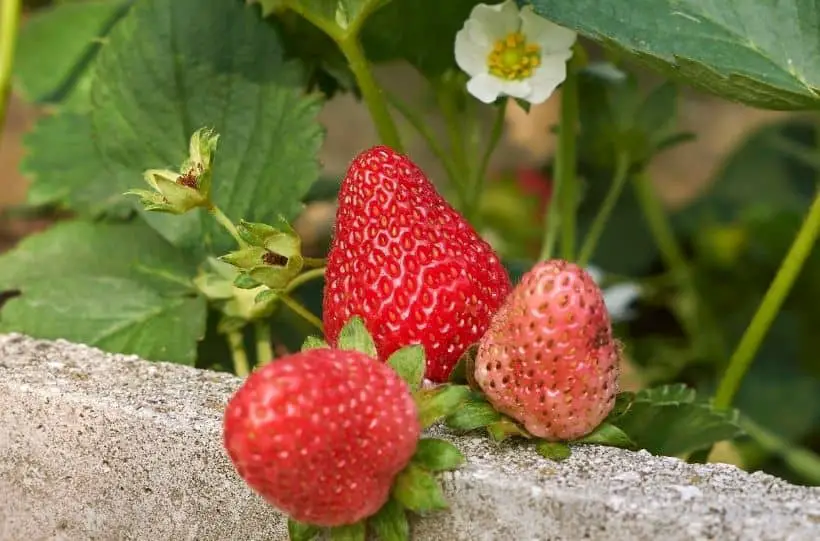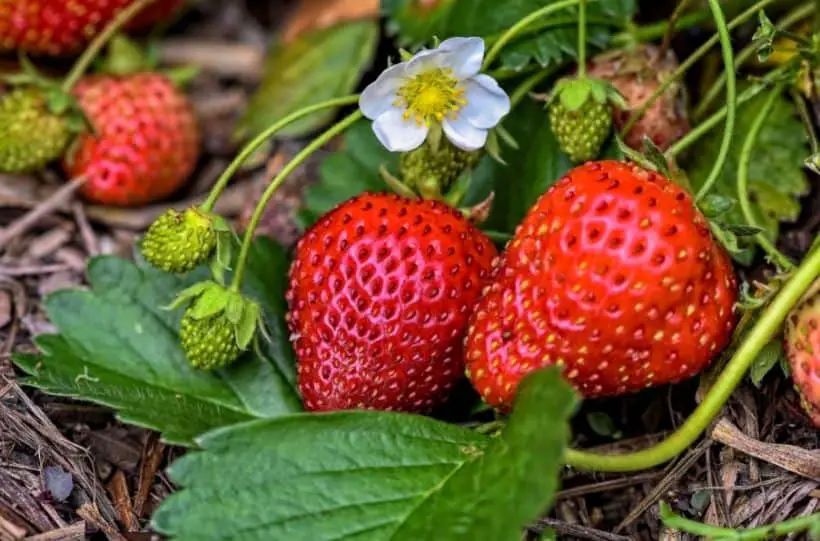Quinault Strawberries: Tips For Growing At Home
Quinault strawberries are the go-to choice for many gardeners when it comes to selecting a strawberry variety to grow in their garden.
It’s no surprise with Quinault strawberries providing two large harvests every year, making them a great choice for fresh strawberries from your garden. They are easy to grow and do not require much support to maintain throughout the year.
If you are looking for a strawberry variety that produces a larger yield of strawberries and doesn’t require constant care, then Quinault strawberries may be a good choice for your garden.

| Botanical name: | Fragaria x ananassa |
| Common name: | Strawberry ‘Quinault’ |
| Family: | Fragaria |
| Plant Type: | Fruit, Perennial |
| Season of Interest: | Fall, Spring, Summer |
| Attracts: | Bees |
| Flower Color: | White |
| Days To Harvest: | 60 – 70 |
| USDA Zone: | 5, 6, 7, 8, 9 |
| Sun Exposure: | Full Sun |
| Height: | 8″ – 10″ |
| Spread: | 1′ – 2′ |
| Water Needs: | Average |
| Best Places to Plant: | Beds, Patio, and Containers |
What are Quinault Strawberries?
Also known as Fragaria x ananassa, Quinault strawberries are a variety of everbearing strawberries. This means that they provide more than one, sometimes up to three, strawberry harvests every year.
Quinault strawberries produce white-petalled flowers with yellow centers in the spring which, once pollinated, develop into strawberries by early summer. The plant will produce another harvest later in the season right up until winter.
During winter, like most strawberry varieties, Quinault strawberries become dormant to protect themselves. They begin to grow again the following spring when the temperature has increased and the ground has thawed.
Top Tips To Grow Quinault Strawberries
Quinault strawberries are grown very similarly to other varieties of strawberries. They require at least 6 hours of direct sunlight a day and to be planted in an area of rich soil that offers good drainage.
If planting your strawberries from seeds, it is best to start these indoors. You can start them indoors in early spring, around February and March.
Plant seeds on top of the soil in growing containers, adding a sprinkling of soil to cover each seed. Using a spray bottle, water your seeds carefully and then place the tray in an area that gains access to direct sunlight and is draft-free.
Once the seedlings have germinated and the last frost has been, your seedlings can be planted outdoors. Remove the area of any weeds and turn your soil with nutrient-rich compost before planting. Strawberry plants are nutrient hungry and the additional compost will benefit your plants.
When planting Quinault strawberries, make sure to leave the crown of your plants above the soil. They do not grow deep roots and are best planted nearer the surface.
Your strawberry plants will need to be watered regularly and fertilized, especially during the summer.
After your Quinault strawberries have first flowered, contrary to what you might believe, it is best to remove the heads.
Removing the first flowers that bloom will encourage your strawberry plants to generate more growth early in the season. This will lead to even more strawberries being produced throughout the year.
For this reason, it’s also ideal if you remove additional runners that sprout in the first month.
How Do You Care For Quinault Strawberries?
Quinault strawberries are easy to care for but do require consistent support. Ideally, they need watering every week until the summer when they need watering at least twice per week due to the increase in temperature.
They also need additional nutrient support during flowering and whilst the fruits grow. At this stage, add organic fertilizer at least once a month. Avoid fertilizing your strawberries just before harvesting and it can lead to the fruits rotting.
After each growing season at the end of Autumn, your strawberry plants will need protection from harsh winters. Cover the soil around your strawberry plants in mulch to protect the roots. You can also add a protective layer of straw, hessian, or fleece to help prevent frost damage.
Finally, as with most strawberries, Quinault strawberries are susceptible to diseases such as root rot, grey mold, and verticillium wilt. With this in mind, it is best to only use the same strawberry plant for a maximum of three seasons.
After this, replace them with new strawberries planted in a different area of your garden. This will minimize the risk of your new strawberry plants being infected with the same disease early on.

Frequently Asked Questions
Will Quinault Strawberries Come Back Every Year?
As they are a perennial plant, Quinault strawberries do return every year. Even though they are at a lower risk of disease and pests compared with other strawberry varieties, they are still susceptible. With this in mind, it is best to replace your strawberry plants every 3 years.
Should I Cut My Strawberry Plants Back For Winter?
It is a good idea to cut back strawberry plants ready for winter. After the last harvest, trim back the foliage on strawberry plants. This will help redirect the plant’s energy into developing its roots. It also helps your strawberry plants to focus on growing new, fresh shoots the following spring. New shoots will lead to a healthier, fuller crop.
When to Plant Quinault Strawberries?
Quinault strawberries need planting as early as possible in Spring once the risk of frost has passed. As this variety of strawberries has several harvests throughout the year, the earlier it is planted in spring, the more likely it is you will have more than one successful harvest.
Can I Plant Quinault Strawberries In Containers?
Yes, strawberry plants do very well grown in containers. They require the same as if planted in the ground in terms of the amount of direct sunlight and soil quality. However, as water drains much more quickly in a container, you will need to water your strawberry plants, especially during the summer, a lot more frequently than if they were planted in the ground.

With these top tips, you can yield several successful harvests from your Quinault strawberries each year. One Quinault strawberry plant can produce up to 200 fruits in one year. They are ideal for eating fresh, making jams and pies, or even for freezing to enjoy during winter.
Make sure to spend time monitoring your strawberry plants, watering them, and adding fertilizer as and when needed.
There are several different varieties of strawberry plants available, however, selecting Quinault strawberries are a good choice for a guaranteed larger supply.
And if you want to learn more about growing strawberries at home, take a look at these guides next:

